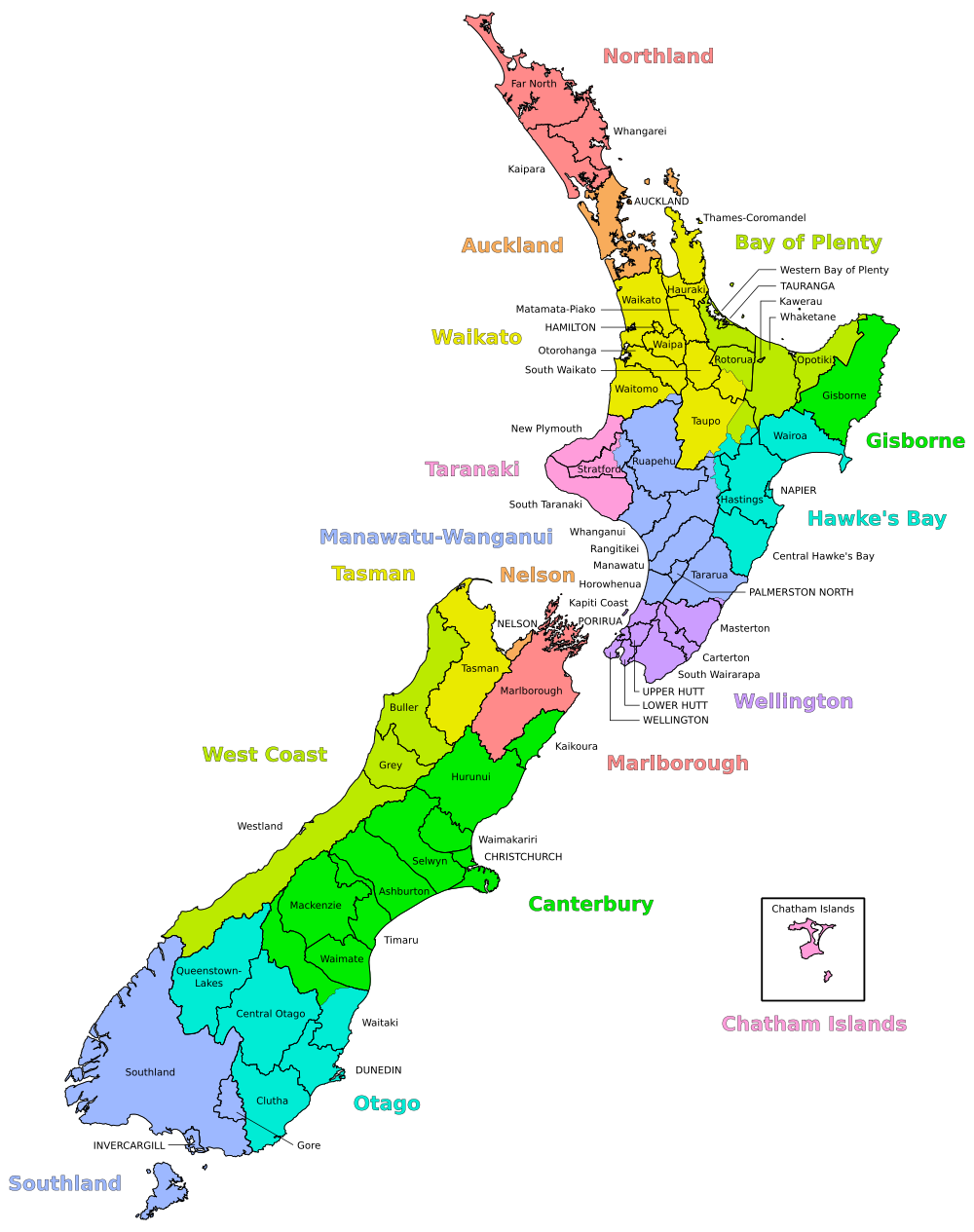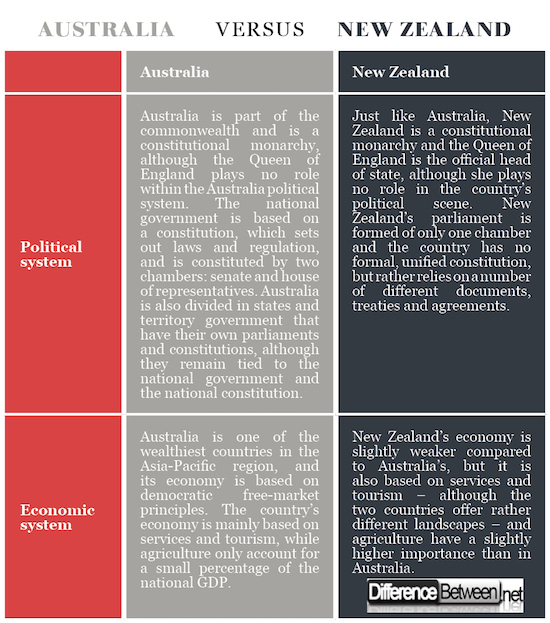Differences Between Australia and New Zealand
Australia and New Zealand are two former English colonies located in the southern hemisphere. Both countries are part of the Asian continent and their geographic proximity – as well as their British roots – translates in some similar cultural and physical features. Yet, at the same time, Australia and New Zealand are very different countries that offer a peculiar juxtaposition and that attract tourists from all over the world. Australia is characterized by endless desert areas and sandy beaches, while New Zealand is famous for its mountains, lakes and green landscapes. In addition, despite having been British colonies, the two countries have a different attitude towards England and have different relations with neighboring countries (i.e. China, Japan, South Korea, etc.) and with their allies (i.e. United States).

What is Australia?
Australia is one of the largest countries in the world, with a total surface of 7.7 million square kilometers, and is characterized by large desert areas that are virtually inhabited. Australia has a total population of around 22.9 million people – much lower than other significantly smaller countries – that is mainly concentrated in the coastal areas and the major urban centers. The Australian population is about 26% English, 25% Australian, 7.5% Irish, 6.5% Scottish, and includes Italian, Chinese, Greek, Dutch, Indian and Australian aboriginal minorities. In fact, before being colonized by the English Captain James Cook in 1770 – who named the country New South Wales – Australia was the land of the Aborigines, who had arrived in the country in 40,000 BC from Asia. The Aboriginal heritage and culture are still rather present in Australia, especially in the outback and the inland territories, whereas in the coastal areas the English and European influence is much more evident.
Some key features in brief:
- Language: English;
- Religion: Christianity;
- Capital: Canberra;
- Currency: Australian Dollar;
- National animal: Kangaroo;
- Head of state: Queen Elizabeth II, represented by a governor-general; and
- Prime Minister: Malcolm Turnbull.
Australia is an advanced country, although significant differences persist between coastal and inland areas. The country’s economy is mainly based on services and industry, while agriculture only represents 4% of total shares. Australia attracts thousands of tourists every year, and offers dreamy sandy beaches and outstanding natural landscapes, where it is not uncommon to found peculiar animals such as kangaroos, koalas, and emus, but also spiders, snakes and crocodiles.
What is New Zealand?
New Zealand is located in close proximity to Australia, and is formed of two main islands and of a number of smaller ones, although the majority of the population lives in the northern island. New Zealand is the land of Maori, an indigenous population that arrived in the island around 1200-1300 AD from other parts of Polynesia. In 1642, Abel Tasman, a Dutch explorer, explores and claims parts of the southern and western coast of the country, while the British captain James Cook arrived in the island only in the 1770s. New Zealand became de facto a British colony, and the British law was imposed in the country in 1840 with the treaty of Waitangi, which includes provisions that aim at protecting Maori land. New Zealand gained full independence from Britain only in 1947, although the British influence is still evident.
Some key features in brief:
- Language: English, Maori;
- Religion: Christianity;
- Capital: Wellington;
- Currency: New Zealand Dollar;
- National animal: kiwi;
- Head of state: Queen Elizabeth II, represented by a governor-general; and
- Prime Minister: Jacinda Ardern.
New Zealand has a surface of 270,534 square kilometers and a population of 4.7 million inhabitants, which is composed of around 70% of Europeans, 14% of Maori, 11% of Asians, and 7-8% of Pacific peoples, while the remaining include Africans, Latin Americans and other ethnicities.

Similarities between Australia and New Zealand
Australia and New Zealand share some common aspects and features. Both countries have been subject to the European, and in particular British, influence, and both are still part of the Commonwealth, which is headed by Queen Elizabeth II. Some of the key common features between the two include:
-
British and colonial roots:
Both Australia and New Zealand are former British colonies and have relatively young urban societies. The two countries were inhabited by indigenous populations – Aborigines in Australia and Maori in New Zealand – that did not live in cities before the arrival of the Europeans. Therefore, urban development was concentrated in the last three centuries;
-
Anzac day:
This is the day in which both Australia and New Zealand remember their fallen soldiers. Anzac day is celebrated on 25 April – date that marks the anniversary of the Australian and New Zealand Army Corps (ANZAC) on the Gallipoli peninsula in 1915;
-
Geographic proximity:
Australia and New Zealand are unique countries, located in the Pacific Ocean, and are inhabited by peculiar animals that cannot be found in any other part of the world. Both countries offer spectacular natural landscapes, although Australia offers a mix of desert and sandy beaches while New Zealand has large green lands, forests and rocky mountains; and
-
Regional migration:
Both Australia and New Zealand have witnessed – and continue to do so – large waves of migration from China and other Asian countries. Even though Australia has repeatedly been condemned by the international community for the treatment of some categories of refugees and asylum seekers – who were confined into an island –, most migrants, especially of Chinese origins, have easily integrated within the Australian society. Conversely, Chinese migrants in New Zealand tend to maintain their national identity, without being able to integrate in the local society.
What is the Difference between Australia and New Zealand?
Despite their geographical proximity and their common past as British colonies, Australia and New Zealand have developed into rather different countries, with significant cultural and social differences.
-
Origins of Australia vs New Zealand:
Even though both countries were part of the British empire – and are still part of the Commonwealth – Australia was a penal colony while New Zealand was a religious colony. Australia is the land where Britain sent its convicts, while the colony of New Zealand was founded to spread Britain’s religious ideals; and
-
Indigenous population in Australia vs New Zealand:
Before the British colonization, both Australia and New Zealand were inhabited by indigenous populations with strong cultures and traditions. Australia was the land of the Aborigines, who were divided into several tribes and used over 250 different languages. Conversely, New Zealand was the land of the Maori population, which is still very present in the modern society. Maori is one of New Zealand’s official languages and Maori traditions – such as tattoos and tribal rituals – are very important in the country, while there is no official Aboriginal language in Australia because of the large diversity of Aboriginal tribes.
Australia vs New Zealand: Comparison Chart
Australia and New Zealand have been subjected to different historic, cultural and environmental influences that forged them into two rather different countries and societies. In fact, aside from significant differences in their origins and indigenous populations, there are other key factors that differentiate the two.

Summary of Australia and New Zealand
Australia and New Zealand are two unique countries located in the southern hemisphere in the Pacific Ocean. Both countries offer amazing landscapes and are populated by extravagant animals that cannot be found in other parts of the world. Australia and New Zealand are united by their common past as British colonies, and both are still part of the Commonwealth, but they have been subject to different historic, cultural and environmental influences that have forged them into very different countries. Yet, in both countries survives a strong attachment to the land and to the original populations – Maori in New Zealand and Aborigines in Australia – even though the European influence is evident in both places.
- Difference Between Michelle Obama and Melania - January 29, 2019
- Difference Between Trump and Modi - December 4, 2018
- Difference Between Carbon Tax And Cap And Trade - December 4, 2018
Search DifferenceBetween.net :
Leave a Response
References :
[0]Hennessy, Kevin, et al. "Australia and New Zealand." (2007).
[1]Pittock, Barrie, et al. "Australia and New Zealand." Climate change (2001): 591-639.
[2]Trollope, Anthony. Australia and New Zealand.. George Robertson, 1876.
[3]Image credit: https://upload.wikimedia.org/wikipedia/en/thumb/f/fa/NBL_location_map.jpg/640px-NBL_location_map.jpg
[4]Image credit: https://en.wikipedia.org/wiki/Districts_of_New_Zealand#/media/File:NZ_Regional_Councils_and_Territorial_Authorities_2017.svg
